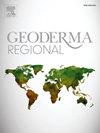Microbial necromass as a critical driver of soil organic carbon accumulation in Qinghai-Tibet Plateau under climate warming: A meta-analysis
IF 3.1
2区 农林科学
Q2 SOIL SCIENCE
引用次数: 0
Abstract
Microbial necromass plays a significant role in soil carbon storage under climate warming, as it is considered a crucial component of the stable carbon pool in soils. However, how the warming, including various warming patterns, affects microbial necromass and its contribution to the organic carbon pool in alpine regions remains largely unexplored. A meta-analysis was conducted utilizing data from ten publications to assess the effects of warming on microbial necromass on the Qinghai-Tibet Plateau. The findings indicated that the soil organic carbon (SOC) content did not exhibit significant changes after warming; however, microbial necromass carbon (MNC) and its ratio to SOC experienced significantly increases of 17.7 % and 52.0 %, respectively. The effect size of warming on fungal necromass carbon (FNC; +19.5 %) was larger than that of bacterial necromass carbon (BNC; +9.2 %). Furthermore, the warming patterns influenced the accumulation of microbial necromass and its ratio to SOC. The accumulation of microbial necromass and its ratio to SOC were increased (19.8 % and 63.9 %) under the low-magnitude warming and slowed down (14.0 % and 20.3 %) under the high-magnitude warming. The MNC and FNC were increased under both long-term warming (1.61 g/kg and 0.86 g/kg) and short-term warming (0.96 g/kg and 0.50 g/kg), but there was no significant change in BNC under long-term warming patterns. The effect sizes of warming on BNC, FNC and MNC were larger in the subsoil (16.3 %, 25.1 % and 24.2 %) than that in the topsoil (7.8 %, 19.1 % and 17.5 %). These results highlight the importance of warming patterns as predictors of microbial necromass. Nonetheless, these conclusions may be restricted by the insufficient sample size, and future researches should expand the sample size to reveal the threshold and mechanism underlying the effect of warming patterns on microbial necromass.

气候变暖背景下青藏高原微生物坏死团块对土壤有机碳积累的影响:meta分析
微生物坏死团块在气候变暖条件下的土壤碳储存中起着重要作用,是土壤稳定碳库的重要组成部分。然而,气候变暖(包括各种变暖模式)如何影响高寒地区微生物死亡及其对有机碳库的贡献仍未得到充分研究。利用10份出版物的数据进行了荟萃分析,以评估变暖对青藏高原微生物坏死的影响。结果表明:增温后土壤有机碳(SOC)含量变化不显著;微生物坏死块碳(MNC)及其与有机碳的比值分别显著增加了17.7%和52.0%。增温对真菌坏死团碳(FNC)的影响+ 19.5%)大于细菌坏死团碳(BNC;+ 9.2%)。此外,增温模式影响了微生物坏死块的积累及其与有机碳的比值。低强度增温增加了土壤微生物坏死块的积累,其与有机碳的比值分别为19.8%和63.9%,而高强度增温则降低了14.0%和20.3%。长期增温(1.61 g/kg和0.86 g/kg)和短期增温(0.96 g/kg和0.50 g/kg)均增加了MNC和FNC,但长期增温模式下BNC无显著变化。增温对底土BNC、FNC和MNC的影响分别为16.3%、25.1%和24.2%,高于表层(7.8%、19.1%和17.5%)。这些结果强调了变暖模式作为微生物坏死预测因子的重要性。然而,这些结论可能受到样本量不足的限制,未来的研究应扩大样本量,以揭示变暖模式对微生物死亡影响的阈值和机制。
本文章由计算机程序翻译,如有差异,请以英文原文为准。
求助全文
约1分钟内获得全文
求助全文
来源期刊

Geoderma Regional
Agricultural and Biological Sciences-Soil Science
CiteScore
6.10
自引率
7.30%
发文量
122
审稿时长
76 days
期刊介绍:
Global issues require studies and solutions on national and regional levels. Geoderma Regional focuses on studies that increase understanding and advance our scientific knowledge of soils in all regions of the world. The journal embraces every aspect of soil science and welcomes reviews of regional progress.
 求助内容:
求助内容: 应助结果提醒方式:
应助结果提醒方式:


